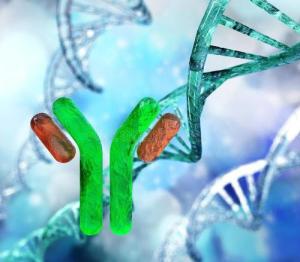


|

| 产地 | 中国 |
| 品牌 | Chemstan |
| 保存条件 | Use a manual defrost freezer and avoid repeated freeze thaw cycles.Store at 4 °C for frequent use.Store at -20 to -80 °C for twelve months from the date of receipt. |
| 货号 | ATA28054 |
| 用途 | 仅供科研用 |
| 应用范围 | WB,ELISA |
| CAS编号 | |
| 抗体名 | DDX50 rabbit Polyclonal Antibody |
| 克隆性 | |
| 靶点 | DDX50 |
| 适应物种 | Human,Mouse |
| 形态 | Liquid |
| 宿主 | Rabbit |
| 包装规格 | 100ul |
| 亚型 | |
| 纯度 | % |
| 标识物 | Unconjugated |
| 浓度 | 1mg/ml% |
| 免疫原 | Synthesized peptide derived from human protein . at AA range: 140-220 |
| 是否进口 | 否 |
用一种包含多种抗原决定簇的抗原免疫动物,可刺激机体多个B细胞*产生针对多种抗原表位的不同抗体。所获得的免疫血清实际上是含有多种抗体的混合物。
产品概述
产品名(Product Name)
DDX50 rabbit Polyclonal Antibody
货号(Catalog No.)
ATA28054
种类(Category)
Primary antibodies
表达宿主(Host)
Rabbit
反应种属(Species specificity)
Human,Mouse
应用实验(Tested applications)
WB,ELISA
*性(Clonality)
Polyclonal
偶连物(Conjugation)
Unconjugated
免疫原(Immunogen)
Synthesized peptide derived from human protein . at AA range: 140-220
产品性能
状态(Form)
Liquid
存放条件(Storage)
Use a manual defrost freezer and avoid repeated freeze thaw cycles. Store at 4 °C for frequent use. Store
at -20 to -80 °C for twelve months from the date of receipt.
纯化方式(Purity)
The antibody was affinity-purified from rabbit antiserum by affinity-chromatography using epitope-specific
immunogen.
应用
WB 1:500-2000 ELISA 1:5000-20000
产品背景
DExD-box helicase 50(DDX50) Homo sapiens DEAD box proteins, characterized by the conserved motif Asp-Glu
Ala-Asp (DEAD), are putative RNA helicases. They are implicated in a number of cellular processes
involving alteration of RNA secondary structure such as translation initiation, nuclear and mitochondrial
splicing, and ribosome and spliceosome assembly. Based on their distribution patterns, some members of
this DEAD box protein family are believed to be involved in embryogenesis, spermatogenesis, and cellular
growth and division. This gene encodes a DEAD box enzyme that may be involved in ribosomal RNA synthesis
or processing. This gene and DDX21, also called RH-II/GuA, have similar genomic structures and are in
tandem orientation on chromosome 10, suggesting that the two genes arose by gene duplication in evolution.
This gene has pseudogenes on chromosomes 2, 3 and 4. Alternative splicing of this gene generates multiple
transcript varia